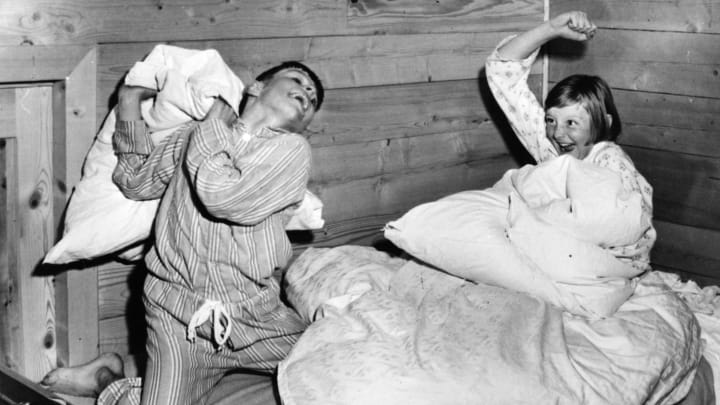8 Pillow Fights That Caused Serious Trouble

International Pillow Fight Day lands on April 2 this year. And while this hallowed occasion is all about whacking your loved ones with your favorite feather-filled weapon of choice, remember to use caution: Pillow fights can lead to some serious trouble. Don’t believe us? Here are some examples of times pillow fights took a turn for the worse, ripped straight from the headlines.
1. "Fights Postponed"
In 1896, a carnival prizefight between pugilists named Fitzsimmons and Maher had to be postponed when "Maher came in here this morning with a badly inflamed eye," The New York Times reported [PDF]. Maher claimed the inflammation was a result of dirt from training, but the Fitzsimmons party insisted it was from a pillow fight Maher participated in under "Vassar College rules" with his trainer. Regardless, Maher claimed he could not fight until the following Monday.
2. "[Boy] Tumbles Out Window During Pillow Fight, but Recovers and Asks for Ice Cream"
In 1921, the New York Tribune reported that a 4-year-old boy named Charles Hunton fell from his building after having a pillow fight with his brother, Arthur. Although Charles was knocked unconscious, a hospital examination found no broken bones or internal injuries. When asked how he was feeling, the boy nonchalantly said he was “fine,” then told his mom to "get me some ice cream."
3. "Wealthy Boy Received His Injuries in a Pillow Fight"
In this hard-hitting bulletin from 1905, The New York Times provided the good news that William Ziegler, Jr., heir to the "great Ziegler estate," was recovering nicely after a pillowy kerfuffle with his school chums—thank goodness!
4. "Hurt in Pillow Fight"
According to the Newcastle Morning Herald and Miners' Advocate, a teenage boy was hurt during a pillow fight in 1948. Don Hewitt got a nasty cut on his forehead after being struck by a light shade, which is clearly a violation of pillow fight etiquette.
5. "The Parliamentary Pillow Fight"
The Gippsland Mercury reported a disorderly scene in the Australian House of Representatives in 1914. The majority party had become peeved with what it saw as obstruction from the opposition, so it proposed an all-night session of parliament. Members of the majority were given blankets and pillows so they could doze off, but opposition members weren't so lucky. It quickly became apparent that the two sides were even worse at sharing linens than they were at building a consensus.
According to the North Western Courier, the opposing sides were soon fighting over pillows and blankets. A wire report described the scene as "a battle royal, recalling nursery days ... soon almost the whole membership of the house was rolling on the floor, wrestling, hitting, and clawing."
6. "Pillow Fight a Fluffy Legal Case"
A pillow fight with 50 participants led to a court date in Vermont in 2009. The Burlington Free Press said the Facebook-scheduled event lasted about two minutes before a policeman strolled by and nabbed a single pillow pugilist. The fighter was given a citation for disorderly conduct, despite no property damage or injuries.
7. "Featherweights: Detroit Police Halt Pillow Fight"
Leave it to the police to ruin yet another good pillow fight. In 2009, another public pillow fight planned at Campus Martius Park was shut down before it even began. The Associated Press said police arrived at the scene and sent potential fighters home. Detroit police spokesperson James Tate said the issue wasn't the fight that they were concerned with—it was the potential cleanup.
8. "He's Convicted in Pillow Fight"
In 1956, The Baltimore Sun reported that 37-year-old Thomas Ruby was convicted of assault—with a pillow. It was John Ruby, the assailant's brother, who pressed the charges, saying he was hit with a pillow and strangled at 2:30 a.m. Thomas was said to have piled up 50 to 60 charges for similar offenses.
A version of this article originally ran in 2015; it has been updated for 2022.